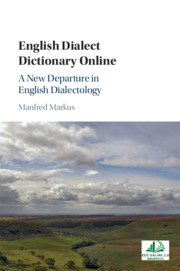Book contents
- English Dialect Dictionary Online
- English Dialect Dictionary Online
- Copyright page
- Contents
- Figures
- Tables
- Preface
- Acknowledgements
- Note on the Text
- 1 Introduction
- 2 Orthography
- 3 Tagging
- 4 The Syntax of EDD Entries, and How to Describe It
- 5 Some Practical Suggestions in Hindsight
- 6 The Interface
- 7 Retrieval Window (Advanced Mode)
- 8 Research Issues Encouraged by EDD Online
- 9 Focus on Quantification
- 10 Final Remarks on the Accessibility and Impact of EDD Online
- Appendix
- References
- Index
4 - The Syntax of EDD Entries, and How to Describe It
Published online by Cambridge University Press: 28 January 2021
- English Dialect Dictionary Online
- English Dialect Dictionary Online
- Copyright page
- Contents
- Figures
- Tables
- Preface
- Acknowledgements
- Note on the Text
- 1 Introduction
- 2 Orthography
- 3 Tagging
- 4 The Syntax of EDD Entries, and How to Describe It
- 5 Some Practical Suggestions in Hindsight
- 6 The Interface
- 7 Retrieval Window (Advanced Mode)
- 8 Research Issues Encouraged by EDD Online
- 9 Focus on Quantification
- 10 Final Remarks on the Accessibility and Impact of EDD Online
- Appendix
- References
- Index
Summary
When we started tagging, we aimed to grasp as many features of the entries as seemed sensible from a philological point of view. However, we met with many difficulties. For example, the 74,000 odd entries included many word-like subsections on compounds, derivations and phrases, most of which would be lemmatised in modern dictionaries. This double membership of such types of word formation as both (formal) ‘sub-lexemes’ and (functional) lexemes in their own rights naturally increased the difficulty of consistently describing the structure of the Dictionary. As regards the dialect distribution of words or forms, Wright has provided information on three different levels: counties (such as Yorkshire), regions (such as East Anglia) and nations, such as England, Scotland, Wales and so on. As to sources, the EDD distinguishes special literature on dialects (which we have finally tagged as title_BIBLIO) from literary texts (such as poems or fiction, which we have called title_LIT). A further source category is that of unprinted information attributed by correspondents (which we have tagged as title_CORRESP). In the case of usage labels, which the EDD provides in abundance, we coined eight basic sub-types, from frequency (LABELFREQ) and reliability (LABELREL) to sub-labels concerning phonology, prosody, morphology, syntax, semantics and pragmatics. Dialect areas and usage labels are unquestionably the two most relevant search filters. The remaining six, for which all strings concerned had to be identified by (capitalised) attribute tags, are parts of speech, phonetic, etymology, morphemic and time spans.
- Type
- Chapter
- Information
- English Dialect Dictionary OnlineA New Departure in English Dialectology, pp. 18 - 22Publisher: Cambridge University PressPrint publication year: 2021



